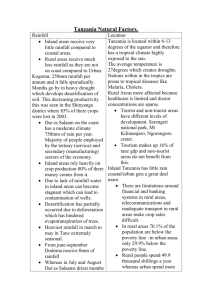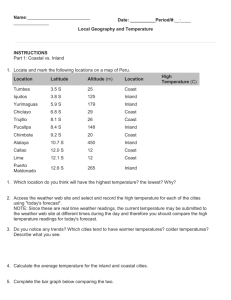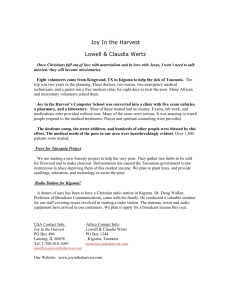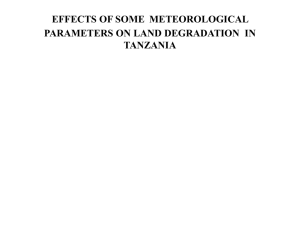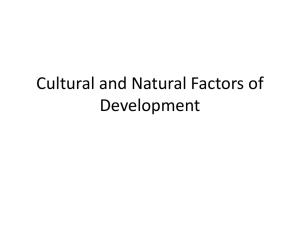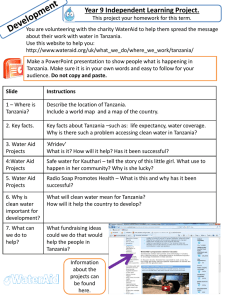What is the grade? L2 Dev
advertisement
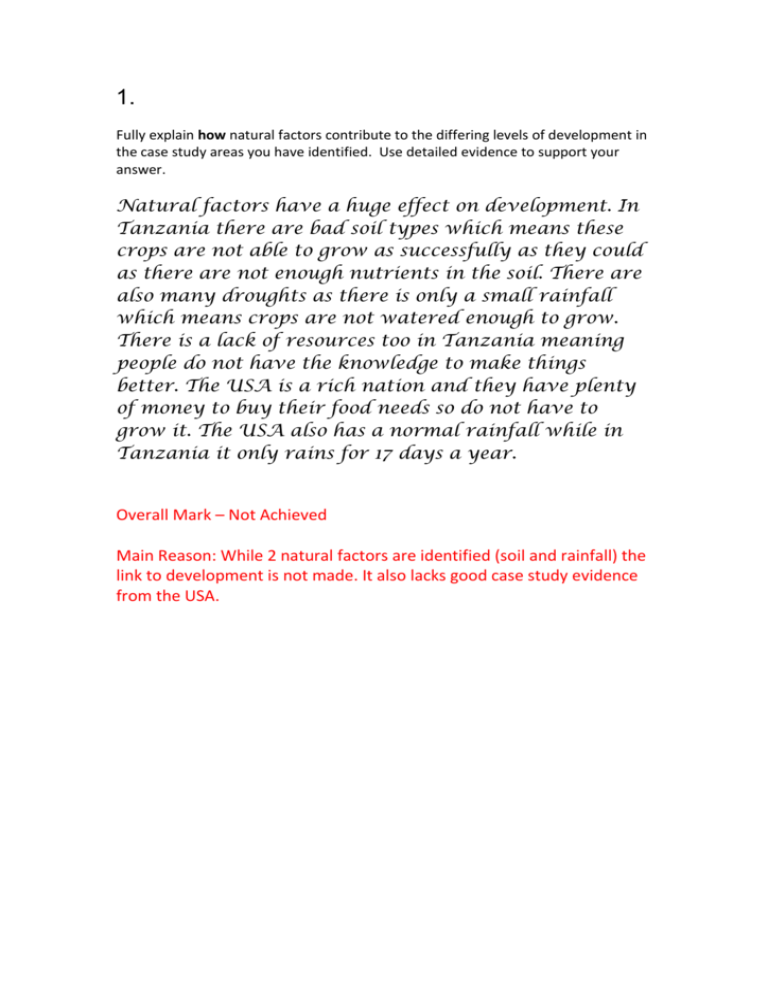
1. Fully explain how natural factors contribute to the differing levels of development in the case study areas you have identified. Use detailed evidence to support your answer. Natural factors have a huge effect on development. In Tanzania there are bad soil types which means these crops are not able to grow as successfully as they could as there are not enough nutrients in the soil. There are also many droughts as there is only a small rainfall which means crops are not watered enough to grow. There is a lack of resources too in Tanzania meaning people do not have the knowledge to make things better. The USA is a rich nation and they have plenty of money to buy their food needs so do not have to grow it. The USA also has a normal rainfall while in Tanzania it only rains for 17 days a year. Overall Mark – Not Achieved Main Reason: While 2 natural factors are identified (soil and rainfall) the link to development is not made. It also lacks good case study evidence from the USA. 2. Fully explain how natural factors contribute to the differing levels of development in the case study areas you have identified. Use detailed evidence to support your answer. One factor that has led to differences in development between coastal and inland Tanzania is rainfall. The coastal regions around Dar-Es-Salaam are much more humid because they are next to the sea. In contrast inland areas around Kigoma are much drier and months of rain are more frequent. These areas only experience about 17 days of rainfall a year. This leads to differences in development as the successful farming possible around the coast due to the rainfall means that cash crops can be sold and exported. This brings in an income to the people living in this region allowing them a better standard of living as they are able to invest in health and education. This in turn leads to more economic development. In contrast the dry conditions inland mean people here struggle to grow enough food to feed themselves and growth of any cash crops is not possible. This leads to a lack of income and a poorer standard of living. Overall Mark – Not Achieved Main Reason: Good understanding of how rainfall has led to differences in development with case study information. However, the question asks for factors (plural) and only one is provided. 3. Fully explain how natural factors contribute to the differing levels of development in the case study areas you have identified. Use detailed evidence to support your answer. Tanzania experiences extreme drought inland where it gets only 250mm compared to the coastal area where it receives much more. Because there is little rain the crops fail which makes the people malnourished and have health problems. This sets them into a cycle of poverty since if they are ill they are unable to work hard to break the cycle. In comparison droughts do not affect the coastal areas like Dar-Es-Salaam where they have enough money to buy imported food and their livelihood is not affected if they cannot produce their own food. The lack of rainfall inland also leads to soil erosion and this is a problem that has increased 20 fold in the last 30 years. Without plants to hold the soil together the top soil is taken away by winds or rains in the wet season. This adds to the problems in inland areas like Kigoma as it creates infertile soils making it even harder to grow crops and gain any income. As a result they lack the money to invest in fertilisers that perpetuates their poverty. In contrast this does not happen in the wealthier coastal areas. Overall Mark –Merit Main Reason: Covers 2 factors of rainfall and soils and gives reasons why this leads to a difference in development. However, depth is only provided for one case study area. 4. Fully explain how natural factors contribute to the differing levels of development in the case study areas you have identified. Use detailed evidence to support your answer. In Tanzania a significant natural factor that has led to differences in development is location. Urban areas are much better developed in terms of their infrastructure and facilities compared to the rural areas inland. Here the only areas that have some level of development are those that are based around tourism such as at Arusha in the North. Here tourism has brought in lots of money that has been invested in the region. As a result 80% of the roads are sealed and money is invested in tertiary education and good modern hospitals. This is in contrast to areas with no tourism such as Kigoma. Here only 1% of roads are sealed and health facilities are very basic. Another natural factor is deforestation. In inland areas 95% of the population rely on wood as a source of fuel for cooking and washing. Over time this resource has been depleted so that locals often have to travel over 20km to collect enough wood for their daily needs. This takes workers away from their other work leading to less family income. In contrast this is not a problem in the urban areas where better infrastructure means that they have electricity for cooking and cleaning. Overall Mark – Not Achieved Main Reason: Neither of the factors chosen is linked to natural factors in the way they are written. Tourism can be included if linked to the natural factors of the game reserves. The second factor here is energy sources and not the trees that could have been a focus. 5. Fully explain how natural factors contribute to the differing levels of development in the case study areas you have identified. Use detailed evidence to support your answer. In Tanzania the most significant natural factor that has led to it being classified as a less developed country is its climate. Tanzania is a country that has a hot, dry climate and where droughts are common. Much of the country experiences only 250 mm of rain a year. Because of these dry conditions the people experience difficulties growing enough food to feed themselves. Without enough rain to sustain any crop growth many of the people become malnourished and ill. As a result they struggle to get an income resulting in a poor standard of living. In contrast in the USA the natural conditions are very good and they have a much better standard of living. Here the main natural factor that has aided its development is the fertile soils. The USA has many flat fertile plains such as the mid west region which are constantly being replenished by the rivers that run through them such as the Colarado. As a result of this farmers are able to grow cash crops easily for export. This brings in a substantial income to the region who are then able to invest in infrastructure such as hospitals and schools that ensure they have a good standard of living. Investment in education and research in turn ensures that future farming is aided by technology that makes it even more efficient and maximizes profit. Overall Mark – Not Achieved Main Reason: different factors are chosen for each case study so does not allow for a comparison of development. This is a shame as each of them is good and could easily be adapted to answer the question. Unpack the Question: Fully explain how natural factors contribute to the differing levels of development in the case study areas you have identified. Use detailed evidence to support your answer. ACHIEVED MERIT EXCELLENCE TWO natural factors are identified. TWO natural factors are identified. TWO natural factors are identified. Each factor is explained for each case study as to how this has caused a difference in development Each factor is explained for each case study showing some depth (may be in one) as to how this has caused a difference in development Each factor is explained for each case study in good depth as to how this has caused a difference in development Some case study evidence to link to an environment is provided Case study evidence to link to an environment is provided (names, statistics or dates) Several references to a case study (names, dates and/or statistics) used throughout. Uses geographic terminology and/or concepts Based on what you have learnt have a go at writing an Excellence answer to this question.
